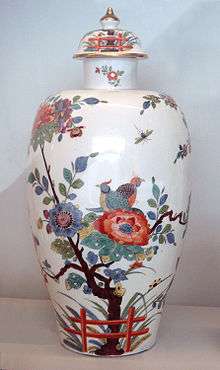Yue ware

Yue ware or in Wade-Giles Yüeh ware (Chinese: 越器; pinyin: Yuèqì; also 越州窯) is a type of Chinese ceramics, a felspathic siliceous stoneware, which is characteristically decorated with celadon glazing.[1][2] Yue ware is also sometimes called "green porcelain" (Chinese: 越州青瓷; pinyin: Yuèzhōu qīngcí, or Chinese: 青瓷; pinyin: qīngcí) in modern literature, but the term is misleading as it is not really porcelain (on Western definitions) and its shades are not really green.[1] It has been "one of the most successful and influential of all south Chinese ceramics types".[2]
The wares covered by the term have been gradually reduced; initially used for a wide range of early celadons with a grey body, it was first made more specific to refer only to wares from north China, and then later only to those from the Tang dynasty onwards, and sometimes to restrict it "to the finest quality wares of the ninth and tenth centuries".[3]
Technique

Yue ware was fired in dragon kilns. The Yue glazing was an ash glaze, made with a recipe using wood ash and clay, and possibly small amounts of limestone.[2] Firing temperature is thought to have been about 1,000°C or slightly higher.[2] The color of the glaze ranges from grey to olive to brown. Yue ware is considered as the ancestor of Song celadon ceramics.[1]
Evolution
Yue ware originated in the Yue kilns of Northern Zhejiang, in the site of Jiyuan near Shaoxing, called in ancient times "Yuezhou" (越州).[1][4] Its name goes back to the Yue (state) of the Spring and Autumn period (770-476 BCE).[2] Yue ware was first manufactured in the 2nd century CE, when it consisted of very precise imitations of bronze vessels, many of which have been found in tombs of the Nanjing region.[1] After this initial phase, Yue ware evolved progressively into true ceramic form, and became a medium of artistic expression.[1][2] Production in Jiyuan stopped in the 6th century, but expanded to various areas of Zhejiang, especially around the shores of Shanglinhu(上林湖) in Yuyao County(余姚县).[1][2]

Yue ware was highly valued and was used as tribute for the imperial court of China in the 9th century.[2] Significantly, it was also used in China's most revered Famen Temple (法门寺)in Shaanxi Province(陕西省).[2] Yue ware was exported to the Middle East early on. In an early example of Chinese influences on Islamic pottery, shards of Yue ware have been excavated in Samarra, Iraq,.[4] From the 8th to the 11th centuries, it was also exported to East Asia, South Asia, and East Africa.[2][5]

A particularly refined form of Yue ware is the Mi-se Yue ware (Chinese: 秘色越器, or Chinese: 秘色青磁, "Secret color Yue ware") found in the Famen Temple and dated to the 9th century. This ware was undecorated but characterized by a smooth and thin glaze of a light color, either yellowish green or bluish green.[2]
Korean celadons were thought to be influenced by Yue ware by the 11th century, and displayed a bluer glaze through the use of low-iron and low-titania lime glazes, closer to the eutectic ideal. However, the Koreans developed their own bluish-green celadon glazes by the Koryo dynasty, that was different from those of Yue wares.[6]
Notes
- 1 2 3 4 5 6 7 The arts of China by Michael Sullivan p.90ff
- 1 2 3 4 5 6 7 8 9 10 11 Chinese glazes: their origins, chemistry, and recreation Nigel Wood p.35ff
- ↑ Medley, 102
- 1 2 Notice of the Metropolitan Museum of Art permanent exhibition.
- ↑ Li Zhiyan; Cheng Wen. Chinese pottery and porcelain. p. 195. ISBN 7-119-00752-1.
- ↑ Chinese glazes: their origins, chemistry, and recreation by Nigel Wood
References
- Medley, Margaret, T'ang Pottery and Porcelain, 1981, Faber & Faber, ISBN 0571109578
External links
| Wikimedia Commons has media related to Yue ware. |
- A Handbook of Chinese Ceramics from The Metropolitan Museum of Art


